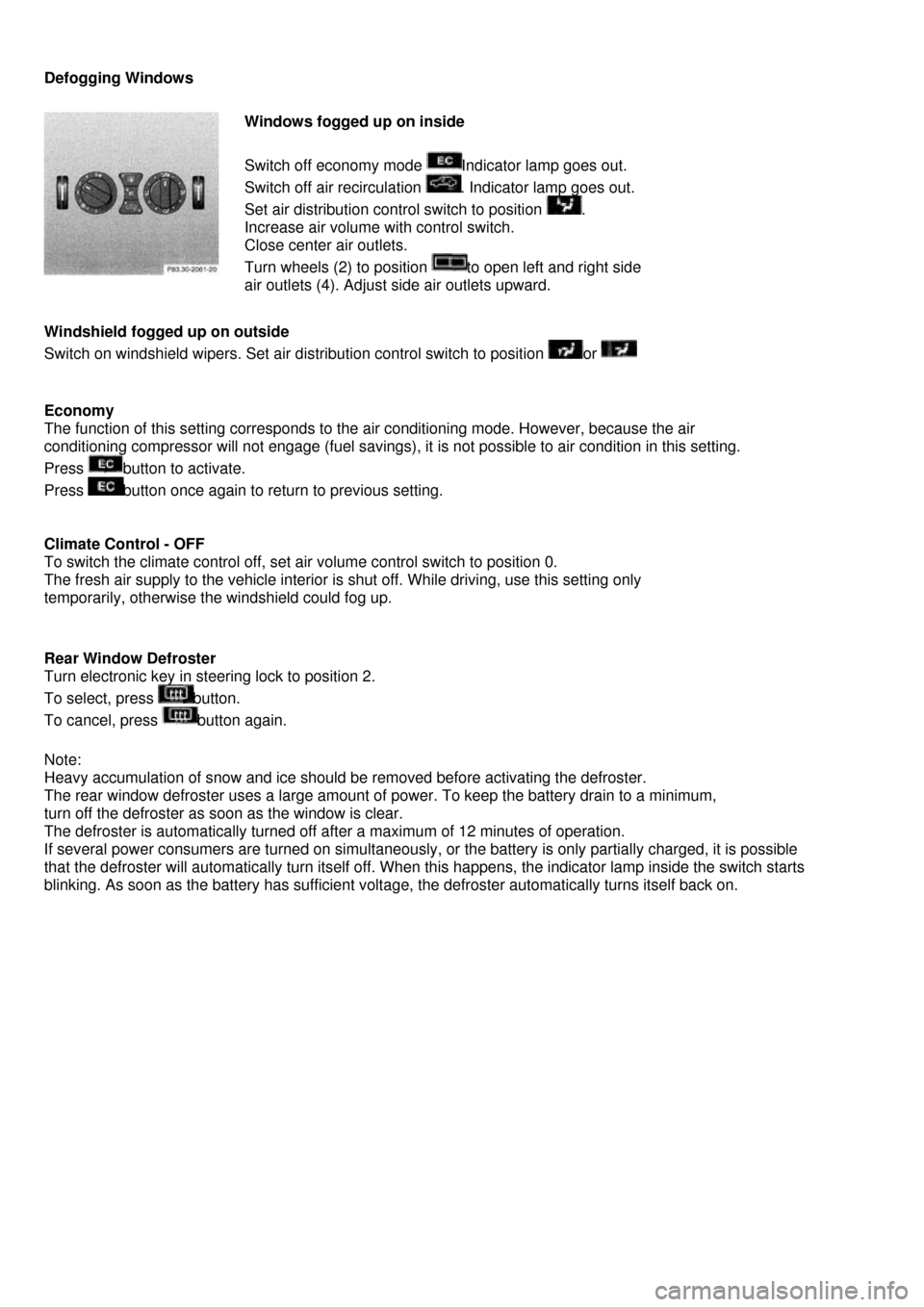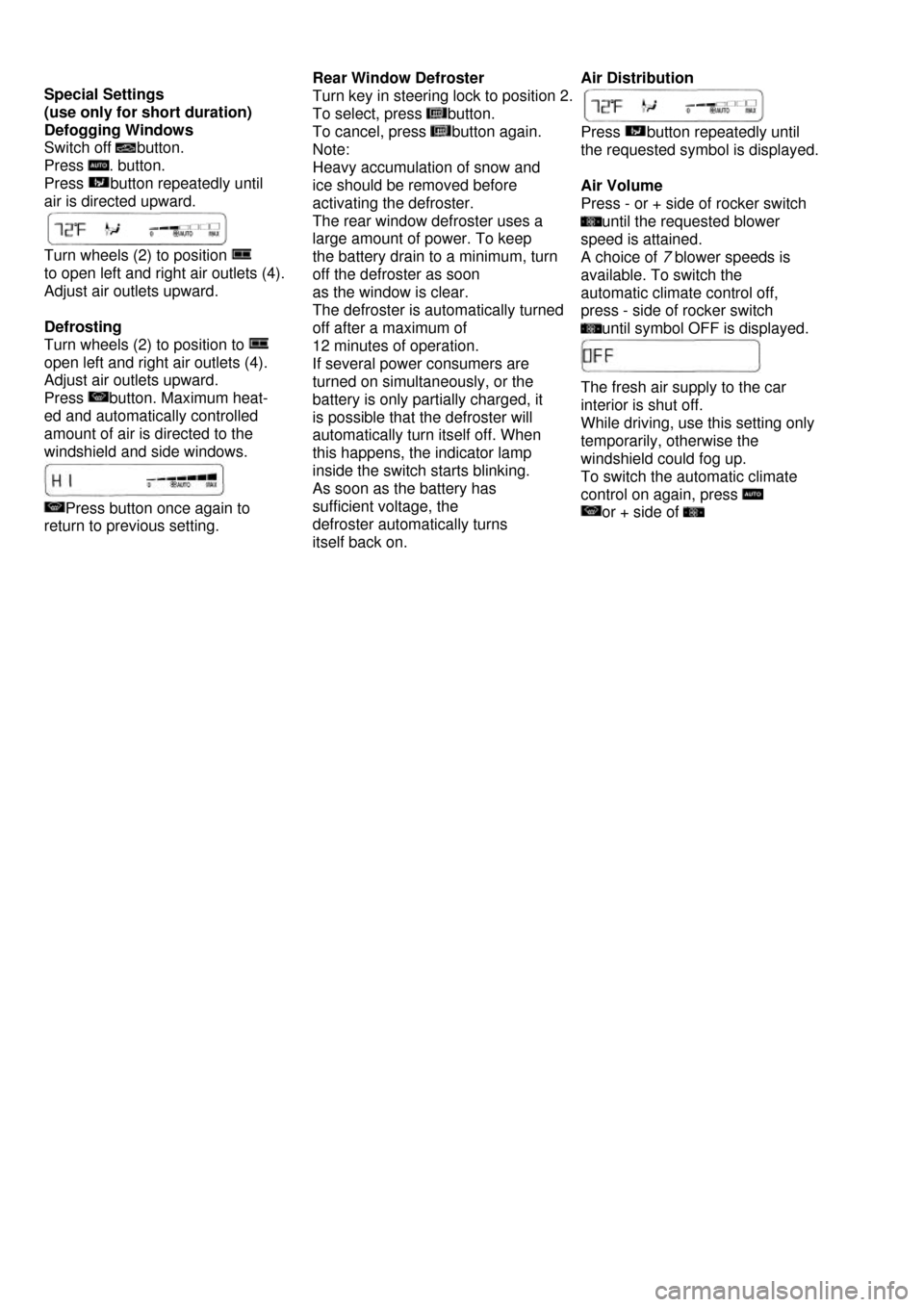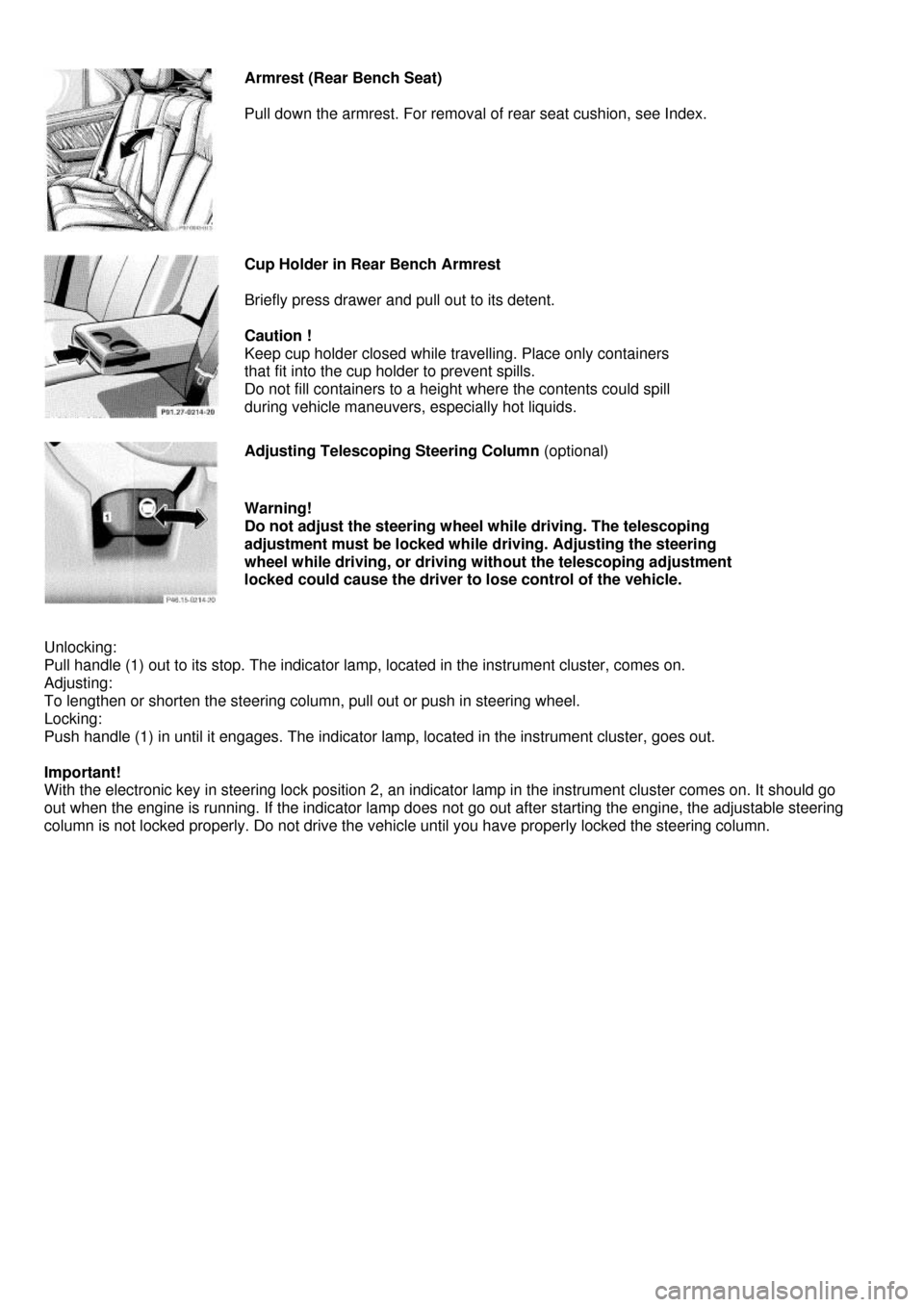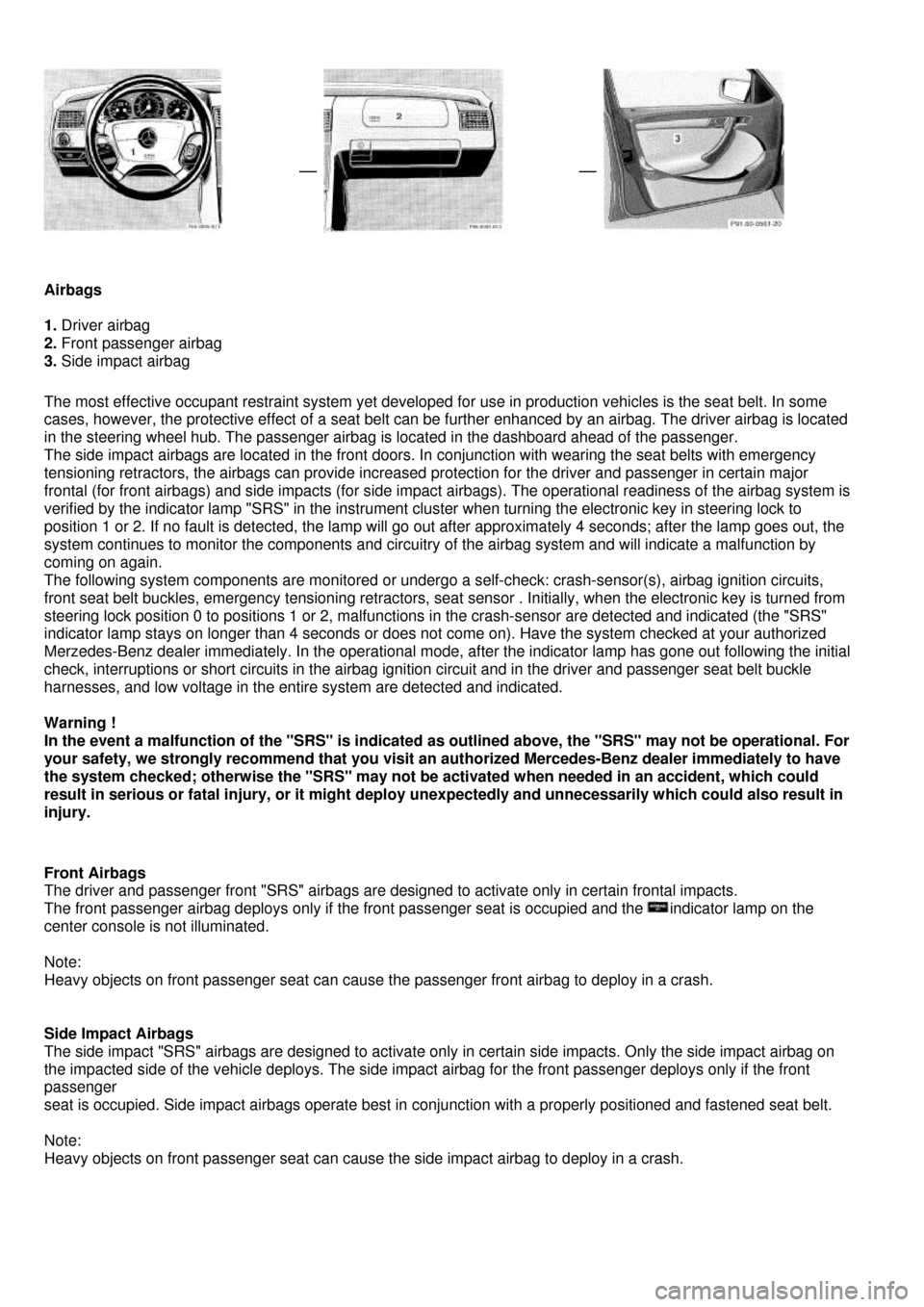steering wheel MERCEDES-BENZ C-Class 2000 W202 Owner's Manual
[x] Cancel search | Manufacturer: MERCEDES-BENZ, Model Year: 2000, Model line: C-Class, Model: MERCEDES-BENZ C-Class 2000 W202Pages: 130, PDF Size: 2.43 MB
Page 3 of 130

Instruments and Controls
For more detailed descriptions see Index.
For adjustments of air outlets, refer to Automatic
Climate Control (see Index).
1. Side air outlet, adjustable
2. Air volume control for side air outlet
3. Exterior lamp switch
4. Parking brake release
5. Hood lock release
6. Parking brake pedal
7. Steering wheel adjustment lever
8. Combination switch
9. Cruise control switch
10. Horn, airbag
11. Instrument cluster
12. Steering lock with ignition/starter switch
13. Center air outlets, adjustable
14. Air volume control for center air outlets
15. Glove box (illuminated with electronic
key in steering lock position 1 or 2)
16. Left front seat heater switch
17. ASR or ESP control switch
18. Switch for rear seat head restraints
19. Hazard warning flasher switch
20. Central locking switch,
21. Switch for Tow-Away Protection
Indicator lamp for antitheft alarm system
22. Right front seat heater switch
23. Climate control (C 230)
Automatic climate control (C 280,
C43 AMG)
Rear window defroster switch
24. Audio system
25. Open storage compartment
26. Ashtray with lighter
27. Storage/eyeglasses compartment
28. Power window switches, front doors
29. Power window safety switch, rear doors
30. Airbag off indicator lamp
31. Power window switches, rear doors
32. Trunk lid release switch
33. Mirror adjustment switch
Page 10 of 130

Tire Speed Rating
Model C 43 AMG only: This vehicle is factory equipped with "Z"-rated tires. All other models: These vehicles are factory
equipped with "H"-rated tires, which have a European spee d rating of 130 mph (210 km/h). An electronic speed limiter
prevents your vehicle from exceeding the speed rating. Despit e the tire rating, local speed limits should be obeyed. Use
prudent driving speeds appropriate to prevailing conditions.
Warning !
Even when permitted by law, never operate a vehicle at speeds greater than the maximum speed rating of the
tires. Exceeding the maximum speed for which tires are rated can lead to sudden tire failure causing loss of
vehicle control and resulting in personal injury and possible death.
Parking
Warning !
To reduce the risk of personal injury as a result of vehicle movement, before turning off the engine
and leaving the vehicle always:
1. Keep right foot on brake pedal.
2. Firmly depress parking brake pedal.
3. Move the selector lever to position "P".
4. Slowly release brake pedal.
5. Turn front wheels towards the road curb.
6. Turn the key to steering lock position 0 and remove.
7. Take the electronic key and lock vehicle when leaving.
Important !
It is advisable to set the parking brake whenever parking or leaving the vehicle. In addition, move selector lever
to position "P". When parking on hills, always set the parking brake.
Winter Driving Instructions
The most important rule for slippery or icy roads is to driv e sensibly and to avoid abrupt acceleration, braking and steering
maneuvers. Do not use the cruise control system under such conditions.
When the vehicle is in danger of skidding, move selector le ver to position "N". Try to keep the vehicle under control by
corrective steering action. Road salts and chem icals can adversely affect braking efficiency.
Increased pedal force may become necessary to produce t he normal brake effect. We therefore recommend depressing
the brake pedal periodically when travelling at length on salt-strewn roads. This can bring road salt impaired
braking efficiency back to normal. A prerequisite is, however, that this is done without endangering other drivers on the
road. If the vehicle is parked after being driven on salt treated roads, the braking efficiency should be tested as soon as
possible after driving is resumed while observi ng the safety rules in the previous paragraph.
Warning !
If the vehicle becomes stuck in snow, make sure that snow is kept clear of the exhaust pipe and from
around the vehicle with engine running. Otherwise, deadly carbon monoxide (CO) gases may enter
vehicle interior resulting in unconsciousness and death. To assure sufficient fresh air ventilation, open
a window slightly on the side of the car that is out of the wind.
Deep Water
Caution !
Do riot drive through flooded areas or water of unknown dept h. If you must drive through deep water, drive slowly to
prevent water from entering the engine compartment or being ingested by the air intake, possibly causing damage to
electrical components or wiring, to engine or transmission t hat is not covered by the Mercedes-Benz Limited Warranty.
Passenger Compartment
Warning !
Always fasten items being carried as securely as possible. In an accident, during hard braking or sudden
maneuvers, loose items will be thrown around inside the vehicle, and cause injury to vehicle occupants unless
the items are securely fastened in the vehicle. The trunk is the preferred place to carry objects.
Page 13 of 130

Defogging Windows
Windows fogged up on inside
Switch off economy mode Indicator lamp goes out.
Switch off air recirculation . Indicator lamp goes out.
Set air distribution control switch to position .
Increase air volume with control switch.
Close center air outlets.
Turn wheels (2) to position to open left and right side
air outlets (4). Adjust side air outlets upward.
Windshield fogged up on outside
Switch on windshield wipers. Set air distribution control switch to position or
Economy
The function of this setting corresponds to the air conditioning mode. However, because the air
conditioning compressor will not engage (fuel savings), it is not possible to air condition in this setting.
Press button to activate.
Press button once again to return to previous setting.
Climate Control - OFF
To switch the climate control off, set air volume control switch to position 0.
The fresh air supply to the vehicle interior is shut off. While driving, use this setting only
temporarily, otherwise the windshield could fog up.
Rear Window Defroster
Turn electronic key in steering lock to position 2.
To select, press button.
To cancel, press button again.
Note:
Heavy accumulation of snow and ice should be removed before activating the defroster.
The rear window defroster uses a large amount of power. To keep the battery drain to a minimum,
turn off the defroster as soon as the window is clear.
The defroster is automatically turned off after a maximum of 12 minutes of operation.
If several power consumers are turned on simultaneously, or the battery is only partially charged, it is possible
that the defroster will automatically turn itself off. When this happens, the indicator lamp inside the switch starts
blinking. As soon as the battery has sufficient voltage, the defroster automatically turns itself back on.
Page 17 of 130

Special Settings
(use only for short duration)
Defogging Windows
Switch off button.
Press . button.
Press button repeatedly until
air is directed upward.
Turn wheels (2) to position
to open left and right air outlets (4).
Adjust air outlets upward.
Defrosting
Turn wheels (2) to position to
open left and right air outlets (4).
Adjust air outlets upward.
Press button. Maximum heat-
ed and automatically controlled
amount of air is directed to the
windshield and side windows.
Press button once again to
return to previous setting.
Rear Window Defroster
Turn key in steering lock to position 2.
To select, press button.
To cancel, press button again.
Note:
Heavy accumulation of snow and
ice should be removed before
activating the defroster.
The rear window defroster uses a
large amount of power. To keep
the battery drain to a minimum, turn
off the defroster as soon
as the window is clear.
The defroster is automatically turned
off after a maximum of
12 minutes of operation.
If several power consumers are
turned on simultaneously, or the
battery is only partially charged, it
is possible that the defroster will
automatically turn itself off. When
this happens, the indicator lamp
inside the switch starts blinking.
As soon as the battery has
sufficient voltage, the
defroster automatically turns
itself back on.
Air Distribution
Press button repeatedly until
the requested symbol is displayed.
Air Volume
Press - or + side of rocker switch
until the requested blower
speed is attained.
A choice of 7 blower speeds is
available. To switch the
automatic climate control off,
press - side of rocker switch
until symbol OFF is displayed.
The fresh air supply to the car
interior is shut off.
While driving, use this setting only
temporarily, otherwise the
windshield could fog up.
To switch the automatic climate
control on again, press
or + side of
Page 26 of 130

Central locking switch
1. Locking
2. Unlocking
The central locking switch is located in the center console. The doors can only be locked with the central locking
switch, if the front doors are closed. If the car was previously locked with the remote control or mechanical key, the
doors and trunk cannot be unlocked with the central locking switch. If the vehicle was previously locked with the
central locking switch, while in the selective remote control mode, only the door opened from the inside is unlocked. If
the vehicle was previously locked with the central locking switch, while in the global remote control mode, the
complete vehicle is unlocked when a front door is opened from the inside.
Note
The fuel filter flap cannot be locked or unlocked with the central locking switch.
Automatic Central Locking
The central locking switch also operates the automatic central locking.
To activate:
With electronic key in steering lock position 2 hold upper portion of switch (1) for a minimum of 5 seconds.
To deactivate:
With electronic key in steering lock position 2 hold lower portion of switch (2) for a minimum of 5 seconds.
With the automatic central locking system activated, the doors and trunk are locked at vehicle speeds of approx. 9
mph (15 km/h) or more. The fuel filler flap remains unlocked.
Notes:
If doors are unlocked with the central locking switch after activating the automatic central locking, and neither door is
opened, then the doors remain unlocked even at vehicle speeds of approx. 9 mph (15 km/h) or more. Opening a door
from the inside at speeds of approx. 9 mph (15 km/h) or less with the automatic central locking activated, the door will
again be automatically locked at speeds of approx. 9 mph (15 km/h) or more.
Important
When towing the vehicle, or with the vehicle on a dynamometer test stand, please, note the following:
With the automatic central locking activated and the electronic key in steering lock position 2, the vehicle doors
lock if the left front wheel as well as right rear wheel are turning at vehicle speeds of approx. 9 mph (15 km/h) or
more. to prevent the vehicle door locks from locking, deactivate the automatic central locking.
Emergency Unlocking in Case of Accident
The doors unlock automatically a short time after an accident (this is intended to aid rescue and exit).
However, the electronic key must still be in the steering lock.
Page 31 of 130

Seats, Front
Warning !
Do not adjust the driver's seat while driving. Adjusting the seat while driving could cause the driver to lose
control of the vehicle. Never ride in a moving vehicle with the seat back reclined. Sitting in an excessively
reclined position can be dangerous.
You could slide under the seat belt in a collision. If you slide under it, the belt would apply force at the
abdomen or neck. That could cause serious or even fatal injuries. The seat backrest and seat belt provide
the best restraint when the wearer is in an upright position and the belt is property positioned on the body.
Never place hands under seat or near any moving parts while a seat is being adjusted
1 - Seat, up/down
2 - Seat, fore7aft
3 - Seat cushion tilt
4 - Backrest tilt
5 - Head restraint
Adjust head restraint to support the back of the head approximately at ear level.
The head restraint angle can also be adjusted manually.
Note:
Your car is equipped with power head restraints, do not try to raise or lower them manually.
Power Seat (Optional on model C230 Kompressor passenger side)
The slide switches are located in each front door. Turn electronic key in steering lock to position 1 or 2 (with a front
door open, the power seats can also be operated with the electronic key removed or in steering lock position 0).
Warning !
When leaving the vehicle always remove the electronic key from the steering lock. The power seats can also
be operated with the driver's or passenger door open. Do not leave children unattended in the vehicle or with
access to an unlocked vehicle. Unsupervised use of vehicle equipment may cause serious personal injury.
Caution !
Do not remove head restraints except when mounting seat covers. For removal refer to Head Restraints, Front, see
Index. Whenever restraints have been removed be sure to reinstall them
before driving.
Important !
Prior to operating the vehicle, the driver should adjust the seat height for proper vision as well as fore/aft placement
and seat back angle to insure adequate control, reach, operation, and comfort. The head restraint should also be
adjusted for proper height. See also airbag section for proper seat positioning. In addition, also adjust the steering
wheel to ensure
adequate control, reach, operation, and comfort, if vehicle so equipped. Both the inside and outside rear view mirrors
should be adjusted for adequate rearward vision. Fasten seat belts. Infants and small children should be seated in a
properly secured restraint system that complies with U.S. Federal Motor Vehicle Safety Standard 213 and Canadian
Motor Vehicle Safety Standard 213. All seat, head restraint, steering wheel, and rear view mirror adjustments as well
as fastening of seat belts should be done before the vehicle is put into motion.
Warning !
Children 12 years old and under must never ride in the front seat, except in a Mercedes-Benz authorized
BabySmart™ compatible child seat, which operates with the BabySmart™ system installed in the vehicle to
deactivate the passenger side airbag when it is properly installed. Otherwise they will be struck by the airbag
when it inflates in a crash. If this happens, serious or fatal injury will result. The back seat is the safest place
for children. Infants and small children must ride in the back seats and be seated in an appropriate infant or
child restraint system, which is properly secured with the vehicle's seat belt, fully in accordance with the seat
manufacturer's instructions. A child's risk of serious or fatal injuries is significantly increased if the child
restraints are not properly secured in the vehicle and the child is not properly secured in the child restraint.
Page 35 of 130

Armrest (Rear Bench Seat)
Pull down the armrest. For removal of rear seat cushion, see Index.
Cup Holder in Rear Bench Armrest
Briefly press drawer and pull out to its detent.
Caution !
Keep cup holder closed while travelling. Place only containers
that fit into the cup holder to prevent spills.
Do not fill containers to a height where the contents could spill
during vehicle maneuvers, especially hot liquids.
Adjusting Telescoping Steering Column (optional)
Warning!
Do not adjust the steering wheel while driving. The telescoping
adjustment must be locked while driving. Adjusting the steering
wheel while driving, or driving without the telescoping adjustment
locked could cause the driver to lose control of the vehicle.
Unlocking:
Pull handle (1) out to its stop. The indicator lamp, located in the instrument cluster, comes on.
Adjusting:
To lengthen or shorten the steering column, pull out or push in steering wheel.
Locking:
Push handle (1) in until it engages. The indicator lamp, located in the instrument cluster, goes out.
Important!
With the electronic key in steering lock position 2, an indicator lamp in the instrument cluster comes on. It should go
out when the engine is running. If the indicator lamp does not go out after starting the engine, the adjustable steering
column is not locked properly. Do not drive the vehicle until you have properly locked the steering column.
Page 43 of 130

Airbags
1. Driver airbag
2. Front passenger airbag
3. Side impact airbag
The most effective occupant restraint system yet developed for use in production vehicles is the seat belt. In some
cases, however, the protective effect of a seat belt can be further enhanced by an airbag. The driver airbag is located
in the steering wheel hub. The passenger airbag is located in the dashboard ahead of the passenger.
The side impact airbags are located in the front doors. In conjunction with wearing the seat belts with emergency
tensioning retractors, the airbags can provide increased protection for the driver and passenger in certain major
frontal (for front airbags) and side impacts (for side impact airbags). The operational readiness of the airbag system is
verified by the indicator lamp "SRS" in the instrument cluster when turning the electronic key in steering lock to
position 1 or 2. If no fault is detected, the lamp will go out after approximately 4 seconds; after the lamp goes out, the
system continues to monitor the components and circuitry of the airbag system and will indicate a malfunction by
coming on again.
The following system components are monitored or undergo a self-check: crash-sensor(s), airbag ignition circuits,
front seat belt buckles, emergency tensioning retractors, seat sensor . Initially, when the electronic key is turned from
steering lock position 0 to positions 1 or 2, malfunctions in the crash-sensor are detected and indicated (the "SRS"
indicator lamp stays on longer than 4 seconds or does not come on). Have the system checked at your authorized
Merzedes-Benz dealer immediately. In the operational mode, after the indicator lamp has gone out following the initial
check, interruptions or short circuits in the airbag ignition circuit and in the driver and passenger seat belt buckle
harnesses, and low voltage in the entire system are detected and indicated.
Warning !
In the event a malfunction of the "SRS" is indicated as outlined above, the "SRS" may not be operational. For
your safety, we strongly recommend that you visit an authorized Mercedes-Benz dealer immediately to have
the system checked; otherwise the "SRS" may not be activated when needed in an accident, which could
result in serious or fatal injury, or it might deploy unexpectedly and unnecessarily which could also result in
injury.
Front Airbags
The driver and passenger front "SRS" airbags are designed to activate only in certain frontal impacts.
The front passenger airbag deploys only if the front passenger seat is occupied and the indicator lamp on the
center console is not illuminated.
Note:
Heavy objects on front passenger seat can cause the passenger front airbag to deploy in a crash.
Side Impact Airbags
The side impact "SRS" airbags are designed to activate only in certain side impacts. Only the side impact airbag on
the impacted side of the vehicle deploys. The side impact airbag for the front passenger deploys only if the front
passenger
seat is occupied. Side impact airbags operate best in conjunction with a properly positioned and fastened seat belt.
Note:
Heavy objects on front passenger seat can cause the side impact airbag to deploy in a crash.
Page 44 of 130

Important !
The "SRS" airbags are designed to activate only in certain frontal (front airbags) impacts, or side (side
airbags) impacts. Only during these types of impacts, if of sufficient severity to meet the deployment
thresholds, will they provide their supplemental protection. The driver and passenger should always wear the
seat belts, otherwise it is not possible for the airbags to provide their intended supplemental protection. In
cases of other frontal impacts, angled impacts, roll-overs, other side impacts, rear collisions, or other
accidents without sufficient forces, the airbag will not be activated. The driver and passengers will then be
protected by the fastened seat belts. We caution you not to rely on the presence of an airbag in order to
avoid wearing your seat belt. The "SRS" is designed to re duce the potential of injury in certain frontal (front
airbags) impacts, and side (side impact airbags) impacts which may cause significant injuries, however, no
system available today can totally eliminate injuries and fatalities.
The activation of the "SRS" temporarily releases a small amount of dust from the airbags. This dust,
however, is neither injurious to your health, nor does it indicate a fire in the vehicle. The service life of the
airbags extends to the date indicated on the label located on the driverside door latch post. To provide
continued reliability after that date, they should be inspected by an authorized Mer cedes-Benz dealer at that
time and replaced when necessary.
Your vehicle was originally equippend with a Suppleme ntal Restraint system (SRS). The SRS airbags are
designet to activate in centrain impacts exceeding a preset treshold to reduce the potential and severity of
injury.merzedes-Benz encourages you to replace deploy ed airbags and repair any malfunktioning airbags to
ensure the vehicle will continue to provid e maximum crash protections for occupants.
Warning!
It is very important for your safety to always be in a properly seated position and to wear your seat belt.
For maximum protection in the event of a collision always be in normal seated position with your back
against
the backrest. Fasten your seat belt and ensure that it is properly positioned on the body. Since the airbag
inflates with considerable speed and force, a proper seating and hands on steering wheel position will help
to keep you in a safe distance from the airbag:
• Sit properly belted in an upright position with your back against the seat back.
• Adjust the driver seat as far as possible rearward , still permitting proper operation of vehicle controls.
• Do not lean with your head or chest close to the steering wheel or dashboard.
• Keep hands on the outside of steering wheel rim. Placing hands and arms inside the rim can increase the
risk and potential severity of hand/arm injury when the driver front airbag inflates.
• Adjust the front passenger seat rearward as far as possible from the dashboard when the seat is occupied.
• Children 12 years old and under must never ride in
the front seat, except in a Mercedes-Benz authorized BabySmart™ compatible child seat, which operates
with the BabySmart™ system installed in the vehicle to deactivate the passenger side front airbag when it
is properly installed. Otherwise they will be struck by the airbag when it inflates in a crash.
If this happens, serious or fatal injury will result . Failure to follow these instructions can result in severe
injuries to you or other occupants.
Safety Guidelines for the Seat Belt, Emergency Tensioning Retractor and Airbag
Warning !
• Damaged belts or belts that were highly stressed in an accident must be replaced and their anchoring
points must also be checked. Use only belts installed or supplied by an authorized Mercedes-Benz dealer.
• Do not pass belts over sharp edges.
• Do not make any modification that could change the effectiveness of the belts.
• The "SRS" is designed to function on a one-time-only b asis. An airbag or emergency tensioning retractor
(ETR) that was activated must be replaced.
• No modifications of any kind may be made to any components or wiring of the "SRS". This includes
the installation of additional trim material, ba dges etc. over the steering wheel hub, front passenger
airbag cover, or front door trim panels, and in stallation of additional electrical/electronic equipment on
or near "SRS" components and wiring. Keep area between airbags and occupants free of objects
( e.g. packages purses, umbrellas, etc.).
• An airbag system component within the steering wheel gets hot
after the airbag has inflated.
• Improper work on the system, including incorrect
installation and removal, can lead to possible injury
through an uncontrolled activation of the "SRS".
• In addition, through improper work there is the risk of rendering the "SRS" inoperative. Work on the
"SRS" must therefore only be performed by an authorized Mercedes-Benz dealer
• When scrapping the airbag unit or emergency tensioning retractor, it is mandatory to follow our safety
instructions. These instructions are av ailable at your authorized Merzedes-Benz
• Depending on the considerable deployment speed and the textile structure of the airbags, there is the
possibility of light skin abrasions.
Page 50 of 130

Steering Lock
0 - The electronic key can be withdrawn in this position only. The steering is locked with the electronic key removed
from the steering lock. The electronic key an be removed only with the selector lever in position "P" and the foot off
the brake pedal. After removing the electronic key or with the electronic key in steering lock position 0, the
selector lever is locked in position "P".
1 - Steering is unlocked. (If necessary, move steering wheel slightly to allow the electronic key to be turned clockwise
to position 1.) Most electrical consumers can be operated. For detailed information see respective subjects.
2 - Driving position.
3 - Starting position.
Refer to Index for Starting and turning off the engine.
Warning !
When leaving the vehicle always remove the electronic key from the steering lock, and lock the vehicle.
Do not leave children unattended in the vehicle, or with access to an unlocked vehicle.
Unsupervised use of vehicle equipment may cause serious personal injury.
Important !
If the electronic key is left in the steering lock position 0 for an extended period of time, it can no longer be turned
in the lock. In this case, remove electronic key from steering lock and reinsert.
Notes:
A warning sounds when the driver's door is opened with the electronic key in steering lock position 1 or 0. With the
engine at idle speed, the charging rate of the alternator (output) is limited. It is therefore recommended to turn off
unnecessary electrical consumers while driving in stop-and-go traffic. This precaution helps to avoid draining of the
battery. Unnecessary strain on the battery and charging system may be minimized by turning off the following power
consumers, for example: Heated seats, rear window defroster. In addition, the automatic climate air volume control
should be set to the lowest position. The steering lock can only be unlocked with the vehicle battery properly
connected.
Caution !
To prevent accelerated battery discharge and a possible dead battery, always remove the electronic key from the
steering lock. Do not leave the electronic key in steering lock position 0.